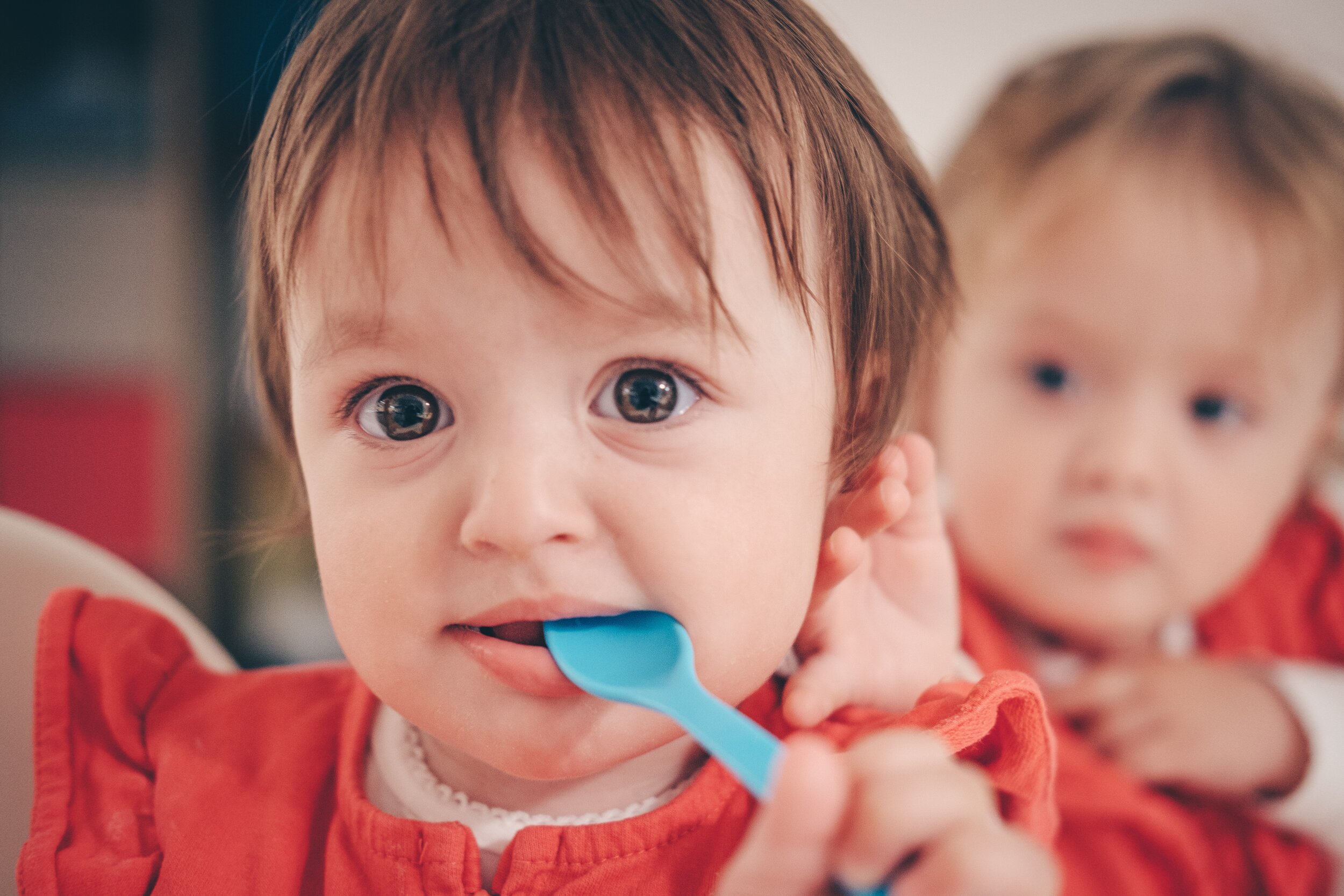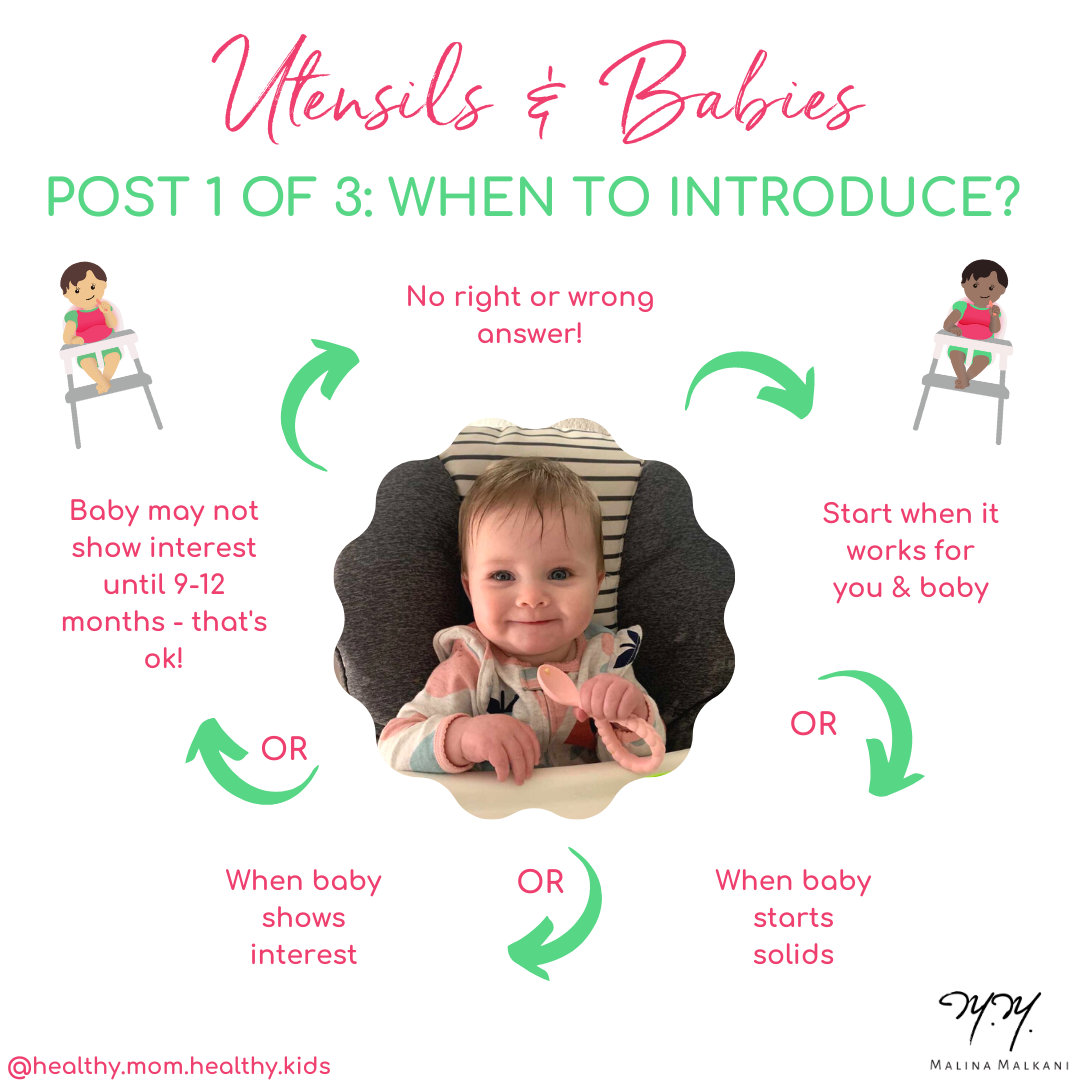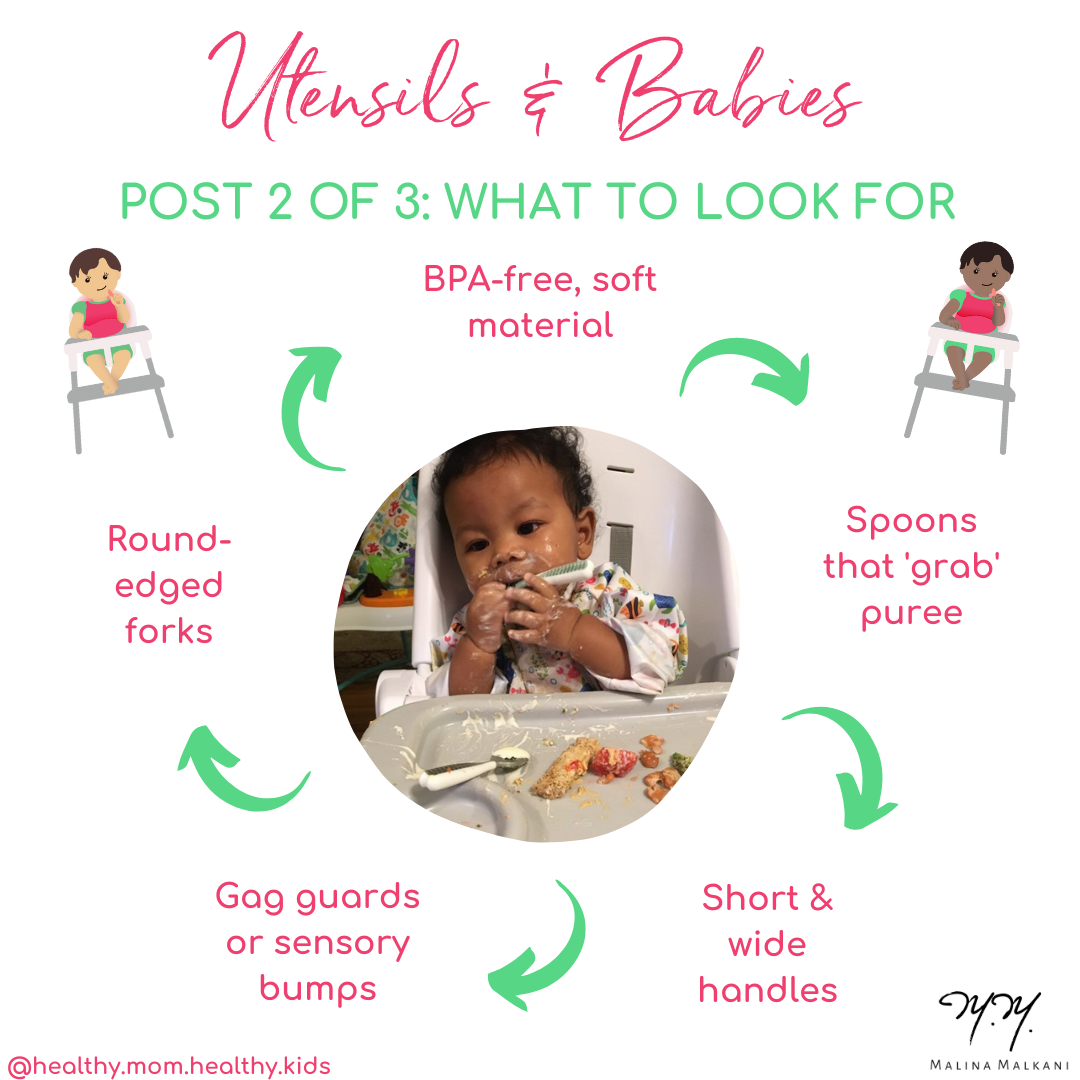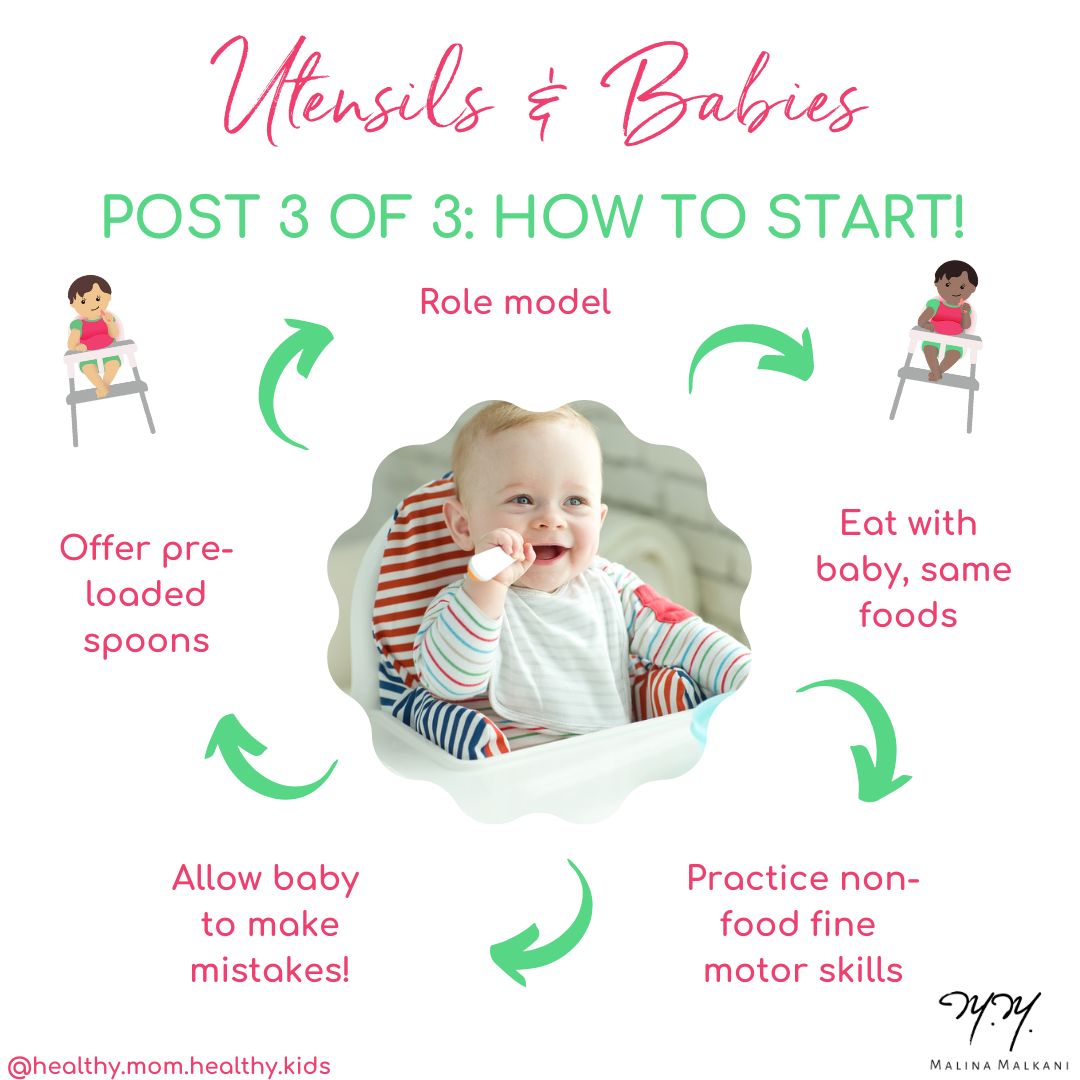How and When Should You Teach Your Baby to Use Utensils?
This blog contains affiliate links, meaning that if you choose to purchase a product through a link, I will receive a small commission - this in no way impacts the amount you pay. Affiliate links are marked with an asterisk (*).
It can take plenty of time and lots of practice for babies to master the fine motor skill of using a spoon and fork.
The process may also require some persistence and patience from you at mealtimes, as the mess can be pretty epic when babies start using spoons and forks, and food often ends up on the floor, in baby’s hair and anywhere else you can think of.
Thankfully, the learning phase doesn’t last forever and is usually over before you know it.
Here’s what you need to know about teaching utensil use in infants and when you can expect for most babies to start using a spoon and/or fork:
When to Teach Utensil Use to Babies
There isn’t one, correct answer on when babies can start using and self-feeding with a spoon. Babies will start using utensils when they have been exposed to them and take an interest.
It’s a good idea to begin exposing your baby to utensils around 6 months or even a bit earlier, when your baby first starts eating solid foods. During the first couple months, your baby may play with utensils more than using them to eat, and that’s okay!
If you think your baby may be distracted by utensils at meal time to the detriment of eating, you can put them aside and try again in 1-2 weeks, although offering mashes and purees on a pre-loaded spoon is a great way to get babies used to using a spoon early on.
Touching, feeling, and watching family members use utensils are also important parts of the learning process. Your baby may not show much interest in utensils until about 9-12 months of age which is perfectly fine as well.
Babies need experience touching and exploring various foods and food textures with their hands, so it's okay to put aside utensils on occasion even if your baby has already started using them, so that you can create plenty of opportunities for your baby to smash, squish, and smear food during meals with hands.
What to Look For When Shopping for Baby Utensils
Here are some attributes to look for when you’re shopping for baby utensils:
Generally plastic-free; always BPA-free
Silicone works well!
Wide handles (easier for baby to grasp)
Short handles* (longer handles make it harder for baby to self-feed and hit the target (i.e., their mouth)
Round-edged forks (less sharp!)
Utensils that look somewhat like adult utensils (this helps babies understand what we’re supposed to DO with utensils as they watch YOU use YOURS!)
Many parents/caretakers find utensils with gag guards helpful. These guards prevent babies from putting the spoon too far into the mouth and triggering a gag reflex.
As an alternative, some baby utensils have sensory bumps, so that babies can use these bumps to feel when a spoon may be going too far into the mouth. The benefit of this feature is that babies receive increased sensory input from the spoon, which helps them become more familiar with the insides of their mouths and how far the spoon can enter before it causes a gag.
Whether to start with a spoon or fork is up to you and your baby. Both a fork and spoon have been recommended as first utensils for different reasons.
Sometimes a pre-loaded fork may work better at first, because the caregiver can help the baby “spear” a small bite of food which then stays on the fork as the baby brings it up to the mouth.
Regular spoons require a steadier hand in order to keep the food in the bowl of the spoon as it makes its way up to the mouth, however pre-spoons that have grooves and ridges can be incredibly helpful for some early eaters because they grab onto mashes and purees. It may take some trial and error to find the right pre-spoons and spoons that work best.
In any case, while learning to scoop with a spoon that has a smooth, deeper bowl is a milestone that usually develops somewhere between 12-24 months, keep in mind that babies are each on their own unique developmental timeline.
How to Teach Utensil Use to Babies
When your little one is first learning how to use utensils, you can offer a pre-loaded pre-spoon with a thickened puree or mash (mashed avocado, Greek yogurt, oatmeal, chia seed pudding, etc.) that stays put when you hand it to baby, even if baby starts waving it around.
If you do this at the beginning of a meal when your baby is hungry, he/she will be more motivated to figure out which end the food is coming from! The NumNum spoons in this collection* are perfect for younger babies eating purees and mashes since they have ridges that “grab” food and help it stay on.
When your baby is first learning how to use utensils, you can guide his/her hand during the scooping up of food with a fork or spoon. Be careful not to interfere too much with the learning process, though! Allowing babies to try on their own and make mistakes is important.
Repeatedly offering utensils, role modeling utensil use for your baby, and practicing non-food fine motor skills are all helpful as babies learn to eat.
Working on fine motor skills with non-food toys helps develop hand-eye coordination and move babies along on the progression from using a palmar grasp to a pincer grasp to pick up food. This development of fine-motor skills also helps babies control utensils with more precision.
Eating meals as a family with your baby, and modeling what to do with a fork and spoon over and over again is powerful as well! One study found that the more young children had incentive to play with fine motor toys such as shape sorters, the more they tended to practice self-feeding with utensils.
The same study showed that exposing babies to situations involving utensil use, such as eating a meal with a playmate or sibling who also uses utensils was also effective in encouraging utensil use.
In any case, patience and persistence go a long way as well! You’ve got this!
If you’re getting ready to start your baby on solids, download my FREE Baby-Led Feeding Essential Checklist to make sure you have everything you need to get started. You might also want to check out my new online course for parents, based on my best-selling book which will walk you through the whole process of starting solids using a baby-led approach.
Alternatively, if your baby is almost ready to start solids and you’re looking for someone you trust to map out the entire first 12 weeks of your baby’s solid food feeding journey, check out my new Safe & Simple 12 Week Meal Plan! Over 30 recipes, weekly shopping lists, tons of balanced baby meals, a complete plan for top allergen introduction, & lots of guidance (with photos) on how to safely serve each food.
Big thanks to my dietitian assistant, Katie Hlucny, RDN for her contributions to this blog post!










